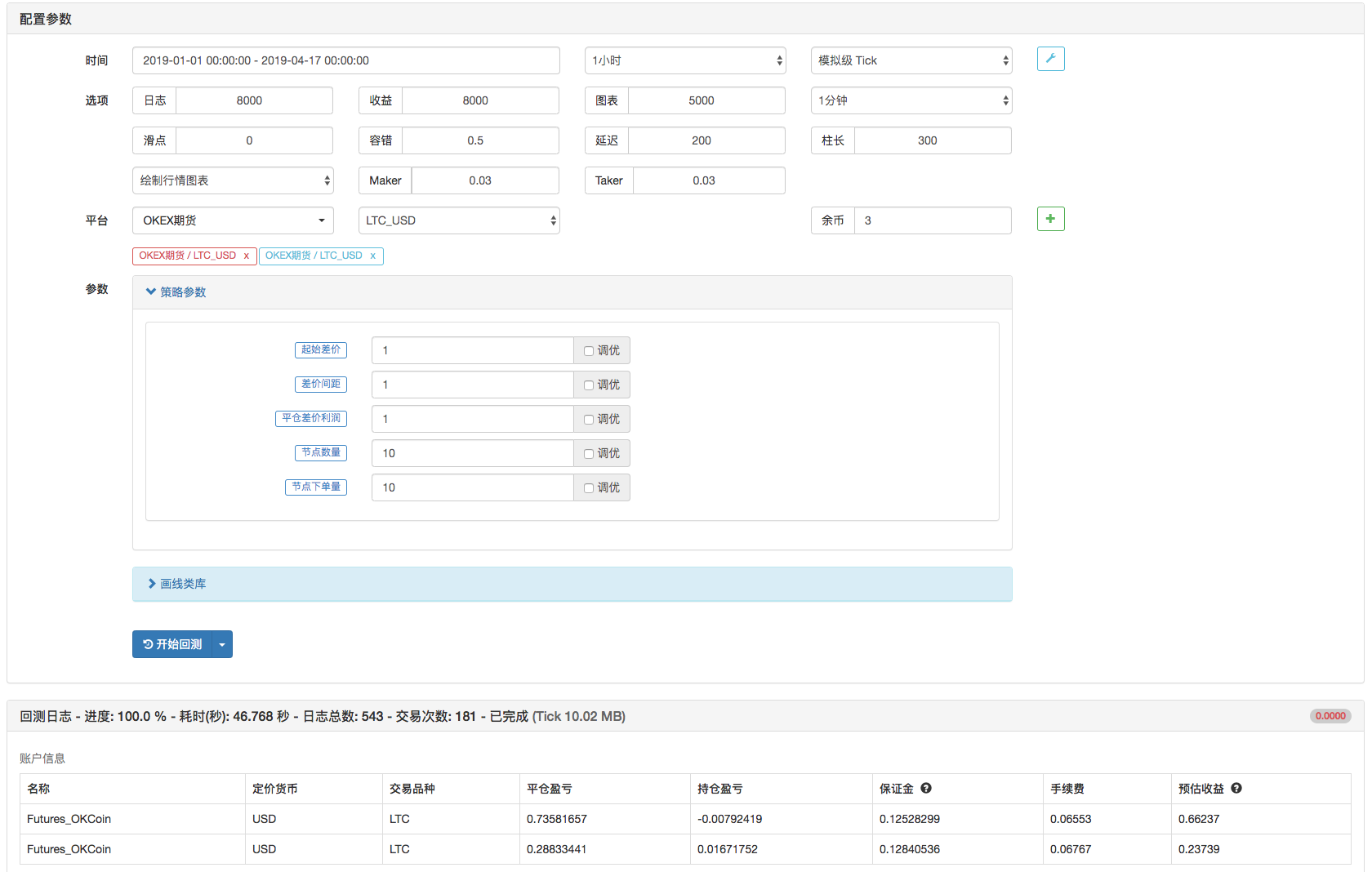rest 버전 OKEX 연장 헤지킹 전략 (교육)
저자:발명가들의 수량화 - 작은 꿈, 2019-04-17 13:30:36태그:연구
매우 간결한 버전의 OKEX 연장 헤지킹 전략 (교육)

-
이 모든 것은 단지 정서일 뿐이고, 반서는 수정될 수 있고, 계약은 교체될 수 있다.
-
두 개의 거래소 객체를 추가합니다. 첫 번째 분기, 두 번째 주간.
-
모든 단순화 가능한 코드를 간소화하고, 최적화 할 수있는 공간이 많으며, 교육 전략은 신중하고, 시간이 넘어가면 위험이 있습니다.
-
이 글은 이 부분의 다른 부분과 같습니다.
교육 전략, 실제 사용.
교육 전략, 실제 사용.
교육 전략, 실제 사용.
function Hedge (isOpen, priceA, priceB) {
exchanges[0].SetDirection(isOpen ? "sell" : "closesell")
exchanges[1].SetDirection(isOpen ? "buy" : "closebuy");
(function (routineA, routineB) {
Log(routineA.wait(), routineB.wait(), priceA, priceB)
})(exchanges[0].Go(isOpen ? "Sell" : "Buy", priceA, _ContractNum), exchanges[1].Go(isOpen ? "Buy" : "Sell", priceB, _ContractNum));
}
var slidePrice = 5
function main () {
var tickerA, tickerB
var arr = []
for (var i = 0 ; i < _Count ; i++) {
arr.push({open: _Begin + i * _Add, cover: _Begin + i * _Add - _Profit, isHold: false})
}
exchanges[0].SetContractType("quarter")
exchanges[1].SetContractType("this_week")
while (1) {
var tab = {type: "table", title: "状态", cols: ["节点信息"], rows: []}
tickerA = exchanges[0].GetTicker()
tickerB = exchanges[1].GetTicker()
if (tickerA && tickerB) {
$.PlotLine("差价:A所-B所", tickerA.Last - tickerB.Last)
for (var j = 0 ; j < arr.length; j++) {
if (tickerA.Buy - tickerB.Sell > arr[j].open && !arr[j].isHold) {
Hedge(true, tickerA.Buy - slidePrice, tickerB.Sell + slidePrice)
arr[j].isHold = true
}
if (tickerA.Sell - tickerB.Buy < arr[j].cover && arr[j].isHold) {
Hedge(false, tickerA.Sell + slidePrice, tickerB.Buy - slidePrice)
arr[j].isHold = false
}
tab.rows.push([JSON.stringify(arr[j])])
}
}
LogStatus(_D(), "\n `" + JSON.stringify(tab) + "`")
Sleep(500)
}
}
관련
- 데리비트 옵션 델타 동적 헤딩 전략 (교육)
- 테스트 관리자와 거래소 서버의 실제 네트워크 지연 / 지원 동시에 여러 거래소를 테스트
- 균형 잡힌 목록 전략 (교육)
- TradingViewWebHook 신호 실행 전략 (교육)
- 슈퍼트렌드 전략 (교육)
- 3줄의 코드는 알고스 머신러닝을 구현하여 업계 뉴스를 빠르게 해석하는 반지개 전략을 구현합니다.
- 코스닥에 신화 첫 번째 로봇을 올립니다.
- 간단한 아이스버그 판매 주문 (복사)
- 간단한 아이스버그 구매 주문 (복사)
- 파이썬 버전 아이스만 위탁 - 판매
- 파이썬 버전 아이스만 위탁 - 구매
더 많은
- 나무 깎기
- 매일 시장 가격 결정
- 삼각형 수당 - 기본 버전
- 삼각차전 전략 체험판
- 코트 시화 통화 계정 간 자금 분할 모범
- 비트코인 비트코인 모델 코드
- 데리빗 웹소켓 예제
- python 상태
테이블 버튼 예제 표시 - boll+maboll
- 심층시장 시장을 통제하는 로봇을 조종하는 시장 도구
- websocket 버전 OKEX 연장간 헤지킹 전략 (교육)
- 60 줄의 삼각형 헤지킹 전략 (교양)
- OkEX 웹소켓 실시간 v3
- 메이어 네트워크 전략
- 무작위 숲에 기반한 트렌드 전략
- 바이낸스 발표를 검색하고 Delist 동전을 판매
- 인터랙티브 템플릿
- 여러 차트 예제
- 계약 헤지 _ 단일 힌트 버전
- M 언어
거북 무역 전략 실행 (V 1.0)
제이미를 사랑해요exchanges[0].Go ((() 이 함수 문서에 설명이 없나요? 어디서 왔으며, 무슨 뜻입니까? 링크를 요청합니다.
1998년안녕하세요, 저자님, 이 전략이 여전히 유효한가요?
fmzero교육용 비디오는 어디 있어요?
제이미를 사랑해요오, 감사합니다, 봤어요, 배웠습니다.
발명가들의 수량화 - 작은 꿈이 API 문서는 http://www.fmz.com/api#exchange.go...
발명가들의 수량화 - 작은 꿈전략은 교육 전략이며, 실제 사용에 신중합니다.
발명가들의 수량화 - 작은 꿈이 코드는 매우 간단하고, 코드를 보면 알 수 있습니다.